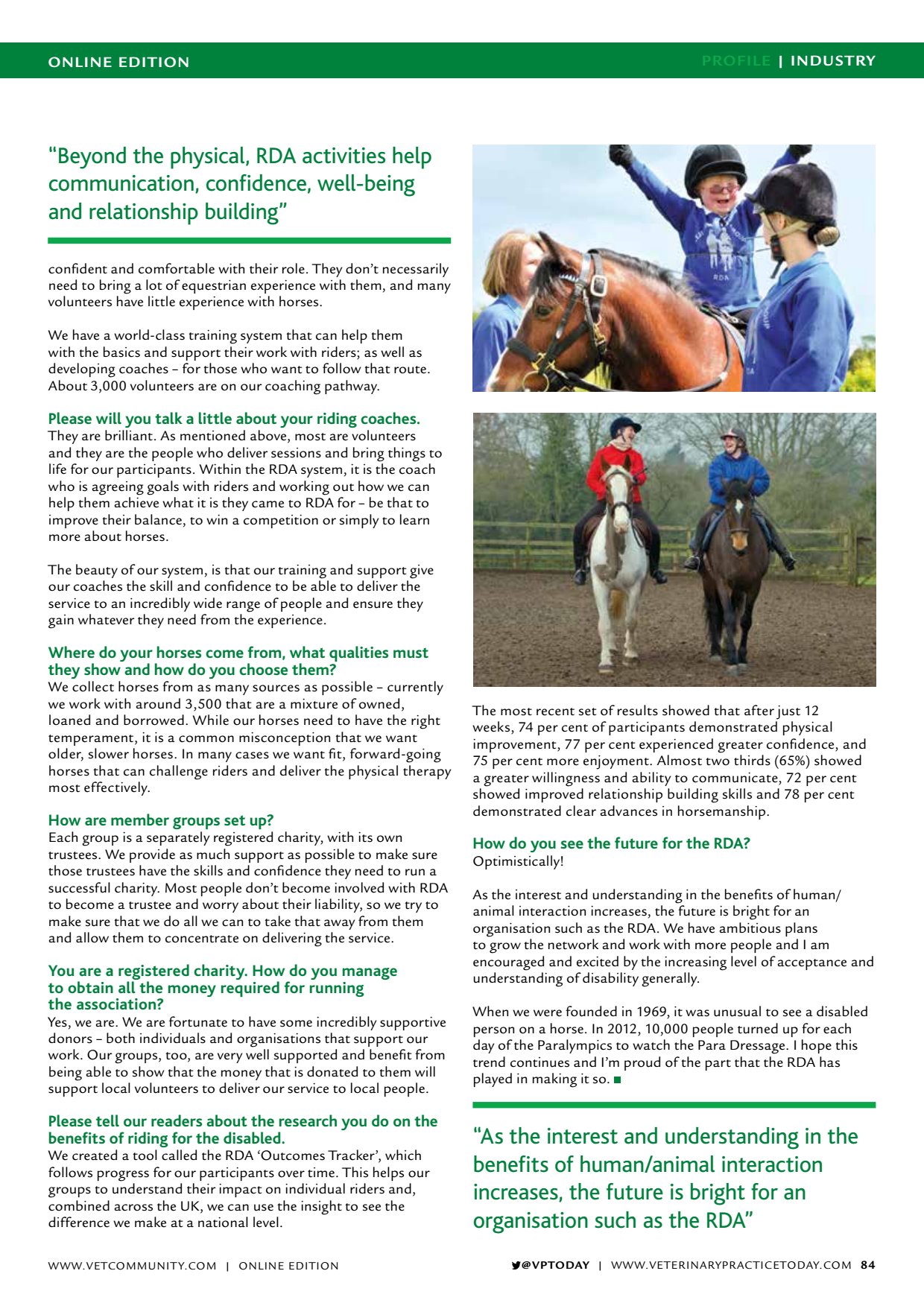Please will talk
ONLINE EDITION PROFILE | INDUSTRY VPTODAY | WWW.VETERINARYPRACTICETODAY.COM 84 confident and comfortable with their role. They dont necessarily need to bring a lot of equestrian experience with them, and many volunteers have little experience with horses. We have a world-class training system that can help them with the basics and support their work with riders; as well as developing coaches for those who want to follow that route. About 3,000 volunteers are on our coaching pathway. Please will you talk a little about your riding coaches. They are brilliant. As mentioned above, most are volunteers and they are the people who deliver sessions and bring things to life for our participants. Within the RDA system, it is the coach who is agreeing goals with riders and working out how we can help them achieve what it is they came to RDA for be that to improve their balance, to win a competition or simply to learn more about horses. The beauty of our system, is that our training and support give our coaches the skill and confidence to be able to deliver the service to an incredibly wide range of people and ensure they gain whatever they need from the experience. Where do your horses come from, what qualities must they show and how do you choose them? We collect horses from as many sources as possible currently we work with around 3,500 that are a mixture of owned, loaned and borrowed. While our horses need to have the right temperament, it is a common misconception that we want older, slower horses. In many cases we want fit, forward-going horses that can challenge riders and deliver the physical therapy most effectively. How are member groups set up? Each group is a separately registered charity, with its own trustees. We provide as much support as possible to make sure those trustees have the skills and confidence they need to run a successful charity. Most people dont become involved with RDA to become a trustee and worry about their liability, so we try to make sure that we do all we can to take that away from them and allow them to concentrate on delivering the service. You are a registered charity. How do you manage to obtain all the money required for running the association? Yes, we are. We are fortunate to have some incredibly supportive donors both individuals and organisations that support our work. Our groups, too, are very well supported and benefit from being able to show that the money that is donated to them will support local volunteers to deliver our service to local people. Please tell our readers about the research you do on the benefits of riding for the disabled. We created a tool called the RDA Outcomes Tracker, which follows progress for our participants over time. This helps our groups to understand their impact on individual riders and, combined across the UK, we can use the insight to see the difference we make at a national level. The most recent set of results showed that after just 12 weeks, 74 per cent of participants demonstrated physical improvement, 77 per cent experienced greater confidence, and 75 per cent more enjoyment. Almost two thirds (65%) showed a greater willingness and ability to communicate, 72 per cent showed improved relationship building skills and 78 per cent demonstrated clear advances in horsemanship. How do you see the future for the RDA? Optimistically! As the interest and understanding in the benefits of human/ animal interaction increases, the future is bright for an organisation such as the RDA. We have ambitious plans to grow the network and work with more people and I am encouraged and excited by the increasing level of acceptance and understanding of disability generally. When we were founded in 1969, it was unusual to see a disabled person on a horse. In 2012, 10,000 people turned up for each day of the Paralympics to watch the Para Dressage. I hope this trend continues and Im proud of the part that the RDA has played in making it so. Beyond the physical, RDA activities help communication, confidence, well-being and relationship building As the interest and understanding in the benefits of human/animal interaction increases, the future is bright for an organisation such as the RDA WWW.VETCOMMUNIT Y.COM | ONLINE EDITION
